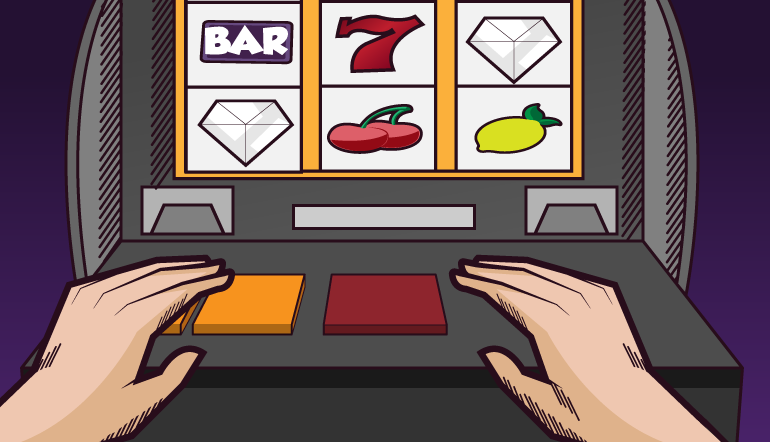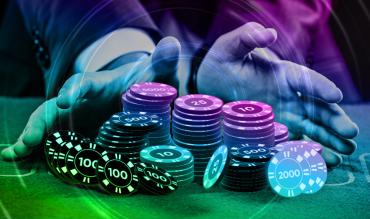- The basics of money management boil down to protecting your money, limiting your losses, making sure you keep some winnings, and limiting the number of chances the house edge has to work against you.
- When you do that, you won't change the house edge or create extra winning spins, but you will make sure your bankroll stays a little fatter and isn't stretched beyond your limits.
Money management is not a magic spell that can turn you into a big winner on the slots.
It can do nothing to change the odds of the games. You'll win sometimes and lose more often no matter how well you manage your money.
But sound money management techniques can help you to limit the losses in the bad times and to keep more of your winnings when the reels and bonuses are kind to you.
That makes learning to manage your money an important skill for anyone who plays slot machines.
The techniques described here are not difficult. Many of them are merely common sense. But they can make a difference in the size of your bankroll.
TIP #1: SET YOUR BANKROLL BEFORE YOU PLAY
Regardless of whether you're playing offline or online casino, give due thought to your stakes for the day.
If you take stock and decide you can afford to risk $100 for the day, then limit your online buy-in to no more than $100, or take no more than $100 in gambling money to a brick-and-mortar casino.
Once you've set your bankroll for the day, don't exceed it. If you've bet your bankroll at $100 and you lose it all, that's it. Don't tap on other funds. Walk away from the games for the day.
If you win or never reach the bottom of your bankroll and can extend your play, terrific. But part of smart money management is to never bet money you can't afford to lose. You want your gambling money to come from an entertainment budget, not from money needed to pay the rent, mortgage, grocery bills or any of the other necessities of life.
TIP #2: KEEP YOUR SLOT MONEY AND MONEY FOR OTHER EXPENSES SEPARATE
That could mean keeping money to play with and money for going out to lunch in separate compartments in your wallet, or it could mean gambling money in your left pocket and other money in your right.
Regardless of how you decide to separate your funds, don't let them mix. You've already set your playing bankroll, and your lunch money is not part of it. When it's time to go to lunch, you want your lunch money to be there.
TIP #3: DO NOT BORROW MONEY TO GAMBLE
That goes double for credit-card advances. Borrowed money is expensive money.
Most offline casinos have machines where you can use your credit cart to initiate a cash advance. You then go to the cashier's cage to sign paperwork and collect your money.
There is a transaction fee that depends on the amount you want to borrow. If, for example, the fee for a $100 advance is $10, it's like adding 10 percent to the house edge. To break even for the day, you'd have take that $100 to the slots and cash out $110.
That doesn't include the monthly interest your credit card company charges on cash advances. Those can exceed 20 percent, and can recur month after month unless you pay your bill in full.
Paying the fees and interest, then playing games on which the house has an edge, makes it all too likely that not only will you lose money, but you'll wind up farther behind than you intended when you set your bankroll.

TIP #4: TRY A SYSTEM OF FLOATING WIN GOALS AND LOSS LIMITS
Win goals and loss limits have been part of the slot player's toolkit for decades.
In their strictest form, the limits have you set both a floor and a ceiling. If you've set your bankroll for the day at $100, then that is your loss limit. If you lose $100 you stop and don't draw on other funds.
At the same time, you set a win goal. If you decide that for your $100 bankroll, you'd consider it a great day if you could walk out ahead by half that amount, then your win goal would be $50.
Any time you reach either your win goal or loss limit, you call it a day. In this example, if your gambling bankroll reaches $150, meaning you're ahead by $50, you stop there and lock up your winnings. If the bankroll reaches zero, of course, you've hit your loss limit and are done for the day.
Most players find a fixed win goal too limiting.
What if you have a $50 winner on your first play? That's easy enough to do with four of a kind on many 25-cent video poker machines, a big bonus round or a mid-level progressive jackpot on a low-limit video slot or a combination such as three triple bars or three 7s on a three-reel slot.
You're probably not going to want to leave after making one bet. You've logged onto the online casino or walked into an offline casino to have a good time, and you want to make it last.
One way stay in action while still using solid money management is to let the win goals and loss limits float, with adjustments in both your floor and ceiling every time you reach a win goal.
With floating goals and limits, it's best to narrow your win goal to 20 percent of your loss limit instead of putting that 50 percent gain in your sights right away.
Let's say you have a $100 loss limit and set your win goal for $20. If you win $20 to bring your bankroll to $120, you've reached your win goal.
At that point, adjust both your win goal and loss limit by that $20 win. You raise the win goal to $40, but you also link it to your loss limit. The loss limit remains at $100, but it's $100 from a bankroll that now stands at $120.
That means you're locking up $20, there for you to take home even if your luck turns sour and you lose $100 from that point.
By doing that, you assure yourself of walking away with at least part of your budget amount without hindering your flexibility to keep playing.
You do the same thing every time you reach a new win goal. In our example, you've won $20, and the new win goal is $40. If you reach $40 in winnings, then you raise the win goal to $60 and you also raise your floor. If you lose $100 from your new total of $140, then you walk away with $40 in your pocket.
The idea is that any time you have a nice winning streak, you make sure you walk away with a little more of your money and don't give it all back to the casino.
The precise amounts of your starting bankroll and the percentage you set as win goals are up to you. There are players who are more comfortable with 10 percent as a win goal; others like 25 or 30 percent.
The small amounts you lock up after reaching each win goal may not seem like much, but coming home with $20 more than you'd budgeted as your floor on multiple casino trips adds up fast. It certainly beats losing early winnings back to the casino time after time.
TIP #5: PUT AWAY AT LEAST HALF OF ANY REALLY BIG WIN
Think of good-sized jackpots as something separate from win goals and loss limits. You want to make sure you bring a large share of the money home.
Don't repeat the sad tale of a video poker player who wrote that she draw a royal flush good for $1,000 on a 25-cent machine. She decided to move up to a dollar machine to see if she could win really big. Instead, she lost it all and went home empty handed.
When you win a jackpot like that, it's OK to try higher denomination games to see if lightning can strike twice for an even bigger jackpot. But it's also important to set limits.
With a $1,000 jackpot, immediately put at least $500 of it away, not to be touched for the rest of your casino outing.
It's your call as to what to do with the other $500. If you want to try a more expensive game, good luck to you. If you want to set a higher loss limit while playing the same games, that works too. If you want to put an even bigger portion of it away, take your partner or friends out to a nice dinner, go to a play, add it to your children's' or grandchildren's' education fund or just put it in savings. more power to you.
With a really enormous, lifestyle-changing jackpot such as the multi-million-dollar payouts on Megabucks, give yourself a cooling-off period. If you want to gamble with an extra few thousand dollars, that's only natural. But leave almost the entire jackpot intact until you've had time to let the initial rush of excitement pass, talk things over with your family or financial adviser, and decide what you really want to do with the money.
The jackpot doesn't have to be anywhere near that large for taxes to come into play, and that brings special needs.
In the United States, for example, the Internal Revenue Service requires casinos to have players sign tax forms before the casino can pay any jackpot of $1,200 or more. The casino usually does not withhold tax money -- it's up to you as a player to pay. Make sure you hold onto enough money to pay the taxes in addition to money you're keeping to bring home.
TIP #6: ON MULTI-DAY TRIPS, DIVIDE YOUR MONEY INTO SESSION BANKROLLS
There are few worse feelings than running out of money on the first day of a casino trip -- and it's a feeling millions of players have had over the decades.
You don't want to pay credit card fees, and you don't want to just avoid the gaming floor either.
One way to make sure you're in action until the end is to divide your bankroll by the number of days for the trip.
If you bring $1,500 to Las Vegas for a three-day trip, budget yourself at $500 per day.
Don't carry the money earmarked for the other two days. Put it in the room safe or some other safe place. Then if you hit your loss limit for Day One, you still have money for Days Two and Three separated.
TIP #7: SLOW DOWN
The faster you play, the more chances the house edge has to work against you.
Don't be in a rush. Take time to walk around the casino and explore what it has to offer. On winning spins, take a few seconds to look at the winning paylines. Order bottles of water or other beverages -- it's good to stay hydrated -- and chat with the waitress. Take frequent breaks.
You don't have to just hit the button as soon as the reels stop over and over and over again. Take your time.


